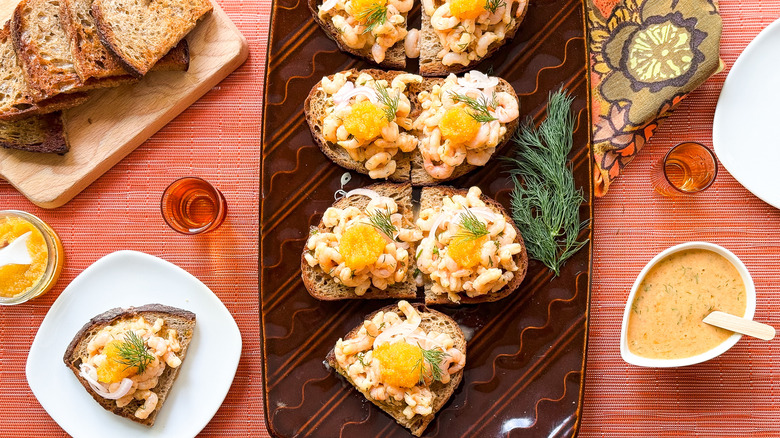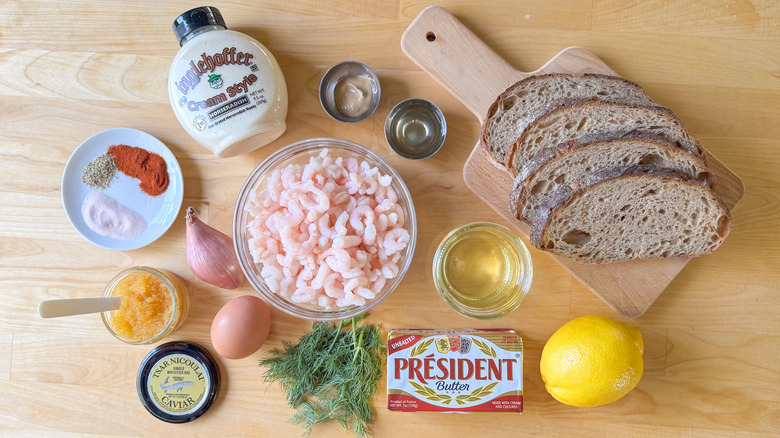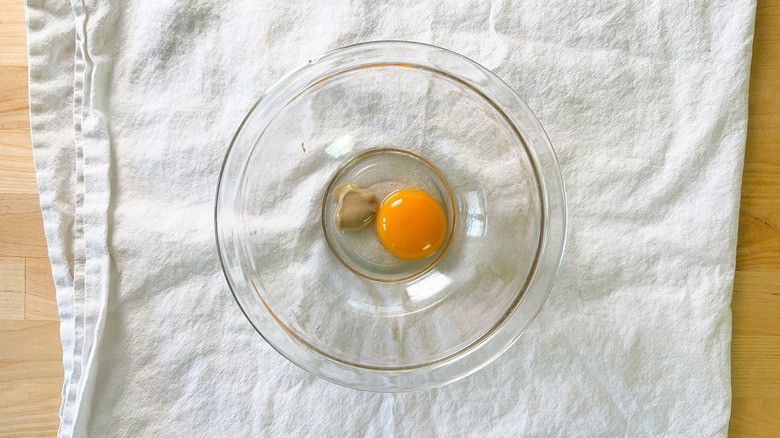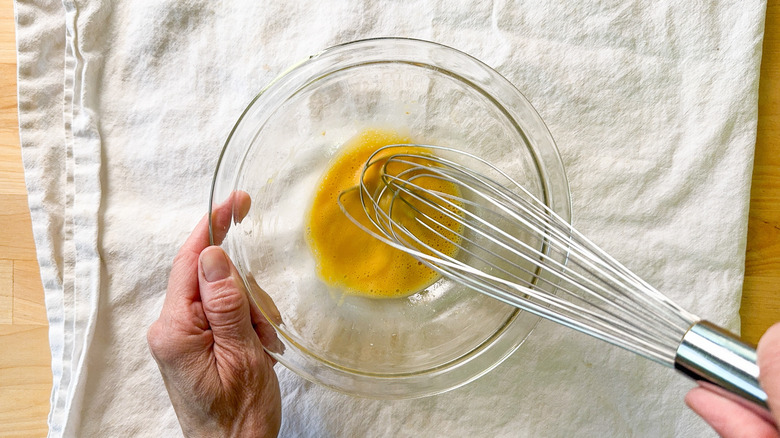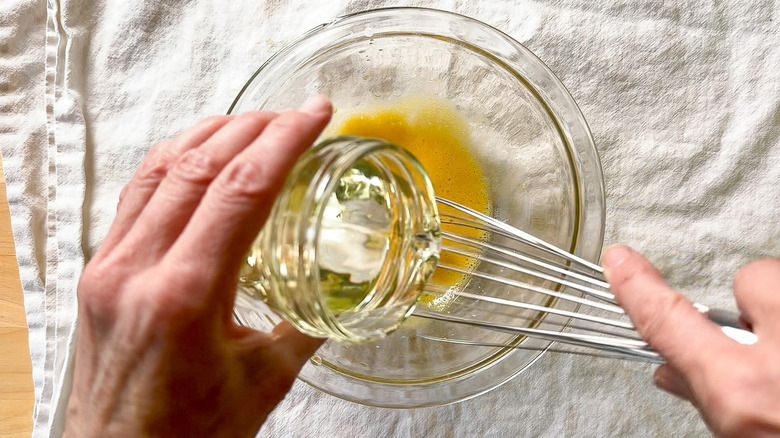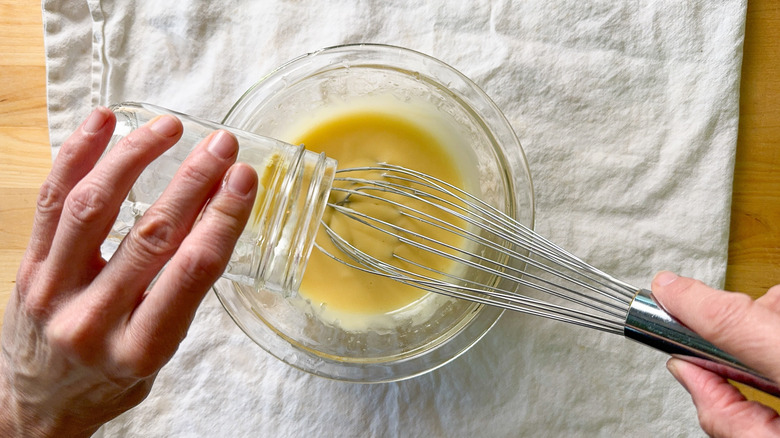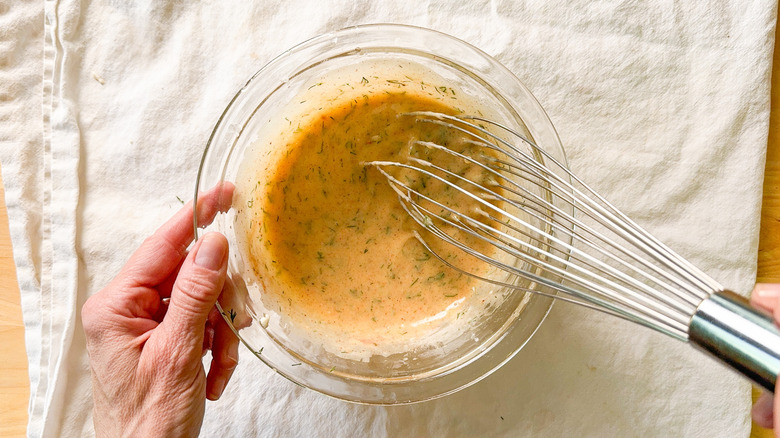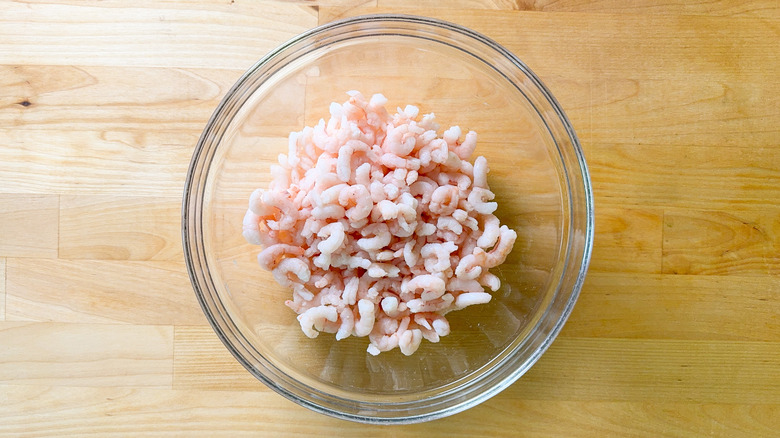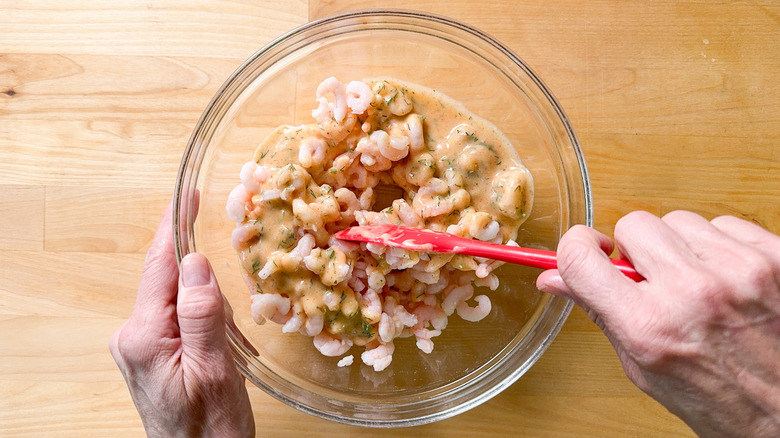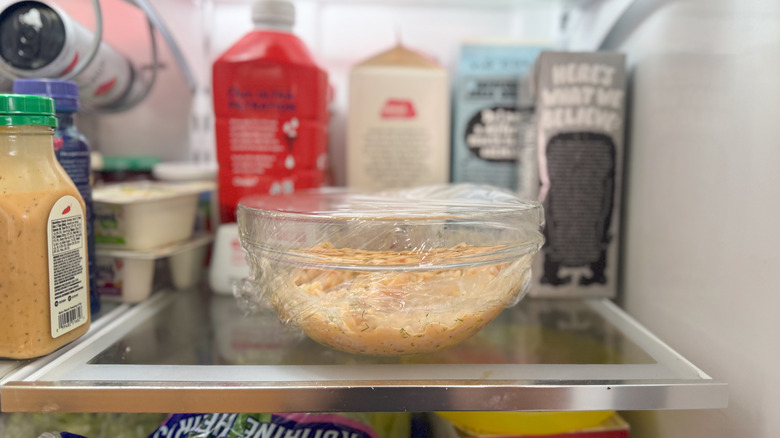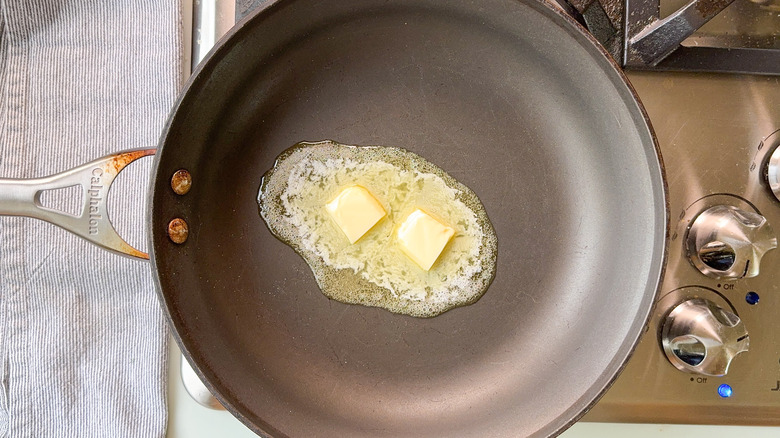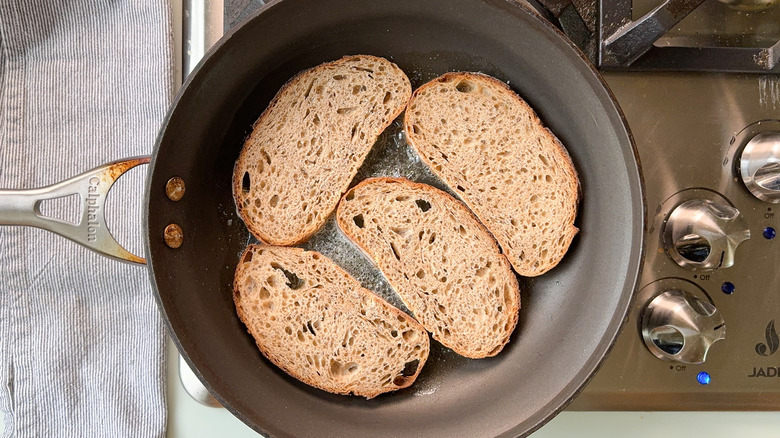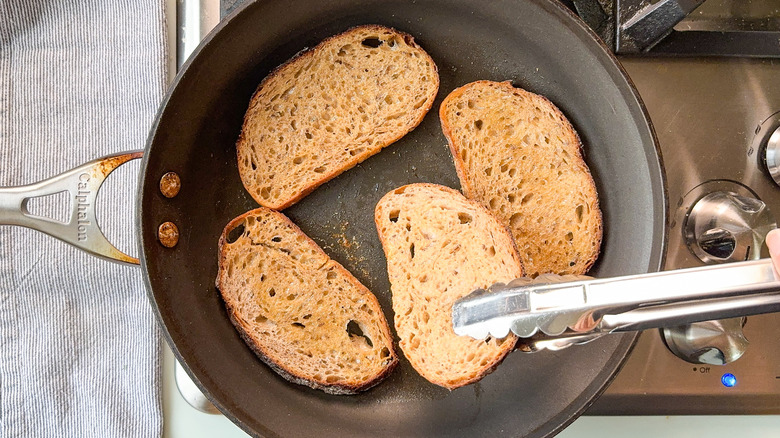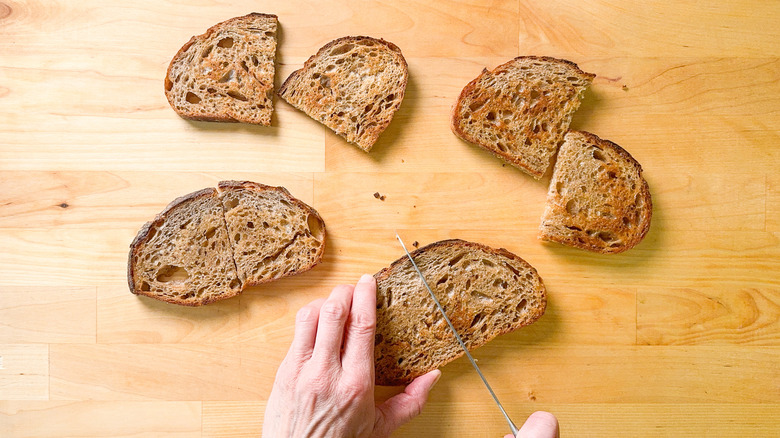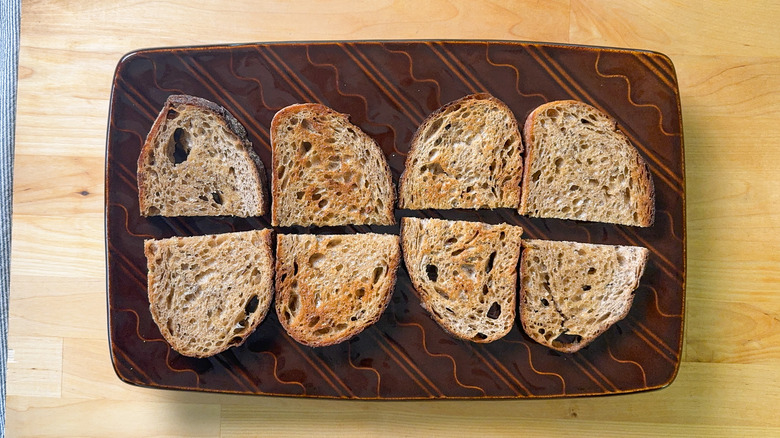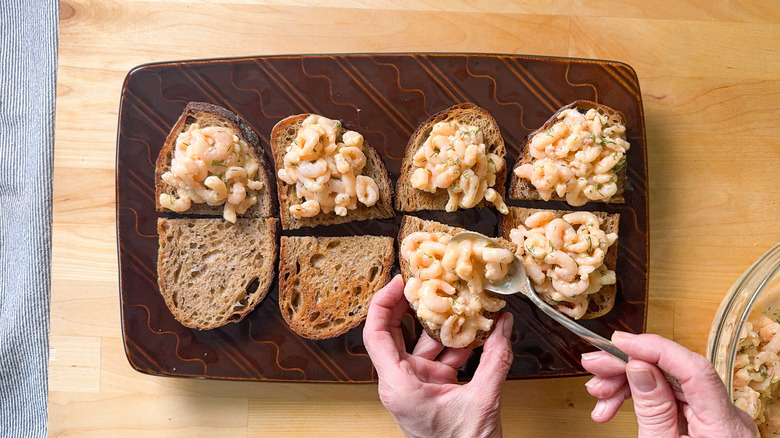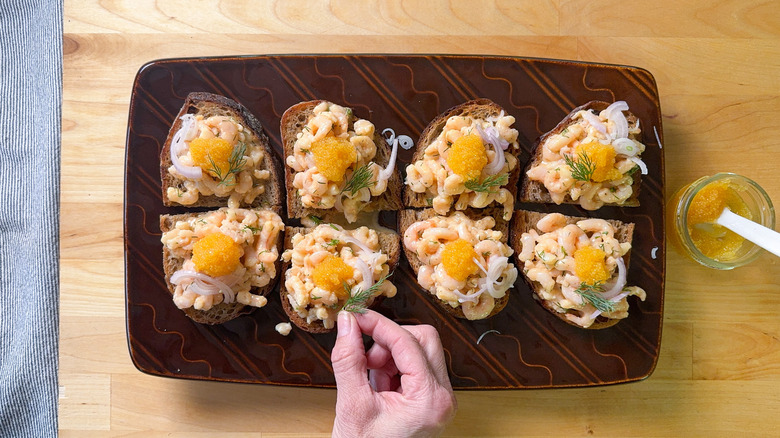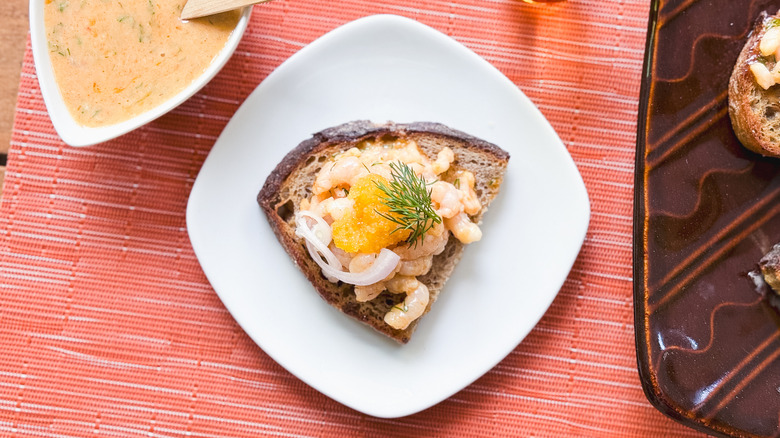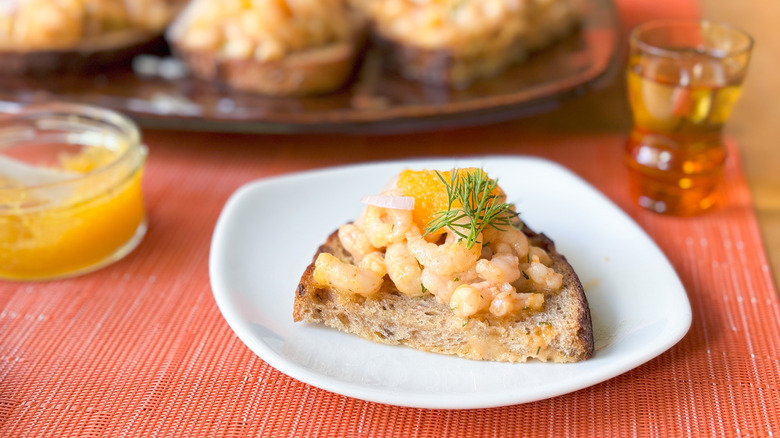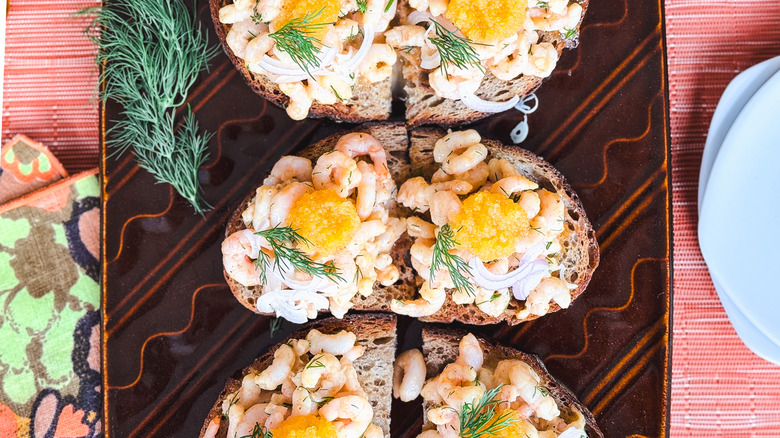Shrimp Salad Toast Skagen Recipe
Toast Skagen is a classic appetizer that is relished across Sweden, but it's actually named after the small Danish fishing town of Skagen. Small, briney shrimp are tossed in a creamy dressing, piled atop crisp, buttered toast, and topped with creamy roe. Many versions of this dish are now found around Scandinavia, but the Swedes have been making it for decades, especially for celebrations (particularly Midsummer).
This recipe for shrimp salad toast Skagen — courtesy of recipe developer Julie Kinnaird – uses crusty rye bread for the toast, tops the bread with tiny cooked salad shrimp, and features a homemade mayonnaise dressing laden with fresh dill, horseradish, lemon, and smoky paprika. The toasts are crowned with a dollop of golden whitefish roe, thinly sliced shallot, and more dill. Adapted from her own Swedish family's archives, Kinnaird says that this recipe is summer in a bite, and it's best enjoyed with a chilled glass of herbacious aquavit!
Gather the shrimp salad toast Skagen ingredients
To make the shrimp salad, you will need to start with tiny salad shrimp, which are classified as 71–90 shrimp per pound. If you want to use larger cooked shrimp, just chop them into ½-inch pieces. To make the mayonnaise dressing, you will need a very fresh egg yolk (the yolk is "cooked" by the vinegar and lemon juice), Dijon mustard, white wine vinegar, a neutral vegetable oil (such as sunflower, safflower, or canola), chopped fresh dill, creamed horseradish, lemon juice, smoked paprika, sea salt, and white pepper. For the toast, choose a crusty rye bread that will be sturdy enough to support the shrimp. Kinnaird likes using a flavorful, European-style butter for skillet-cooking the toast. Thinly sliced shallot and more fresh dill are placed atop each slice, along with your choice of roe (whitefish is traditional).
Step 1: Start the mayonnaise
For the mayonnaise, set a medium-sized bowl over a folded towel for stability and add the egg yolk, mustard, and vinegar.
Step 2: Whisk until smooth
Whisk together until smooth.
Step 3: Add the oil
Slowly add the oil, drop by drop, while whisking constantly.
Step 4: Whisk in the remaining oil
Once the mixture starts to thicken, increase the oil to a steady stream and whisk constantly to emulsify.
Step 5: Add the dill, horseradish, lemon juice, smoked paprika, sea salt, and white pepper
Add the chopped dill, horseradish, lemon juice, smoked paprika, sea salt, and white pepper, whisking to combine.
Step 6: Place the shrimp in a bowl
Pat the shrimp dry and place it in a bowl large enough for mixing.
Step 7: Toss the shrimp with the dressing
Add ⅔ cup of the mayonnaise dressing to the shrimp and gently toss to combine. Reserve the remaining dressing.
Step 8: Cover the bowl and chill
Cover the bowl and chill until ready to use.
Step 9: Melt the butter
Melt the butter in a large, heavy skillet over medium heat.
Step 10: Add the bread to the skillet
Add the bread slices and cook for about 5 minutes.
Step 11: Turn the slices and cook
Turn the slices and cook on the other side until golden and toasted.
Step 12: Cut the slices into halves
Transfer the toast to a cutting board and cut into halves.
Step 13: Arrange the toast on a platter
Arrange the toast on a serving platter.
Step 14: Top with the shrimp salad
Top the toast with the shrimp salad.
Step 15: Garnish the toasts
Garnish the shrimp salad with a spoonful of roe, a few shallot slices, and a sprig of fresh dill.
Step 16: Serve the shrimp salad toast Skagen
Serve the toast Skagen immediately, with the extra dressing on the side for drizzling.
Shrimp Salad Toast Skagen Recipe
This Swedish open-faced toast recipe features small bites of shrimp that are marinated in a herb-filled, mayo-based dressing, and it's a perfect summer bite.
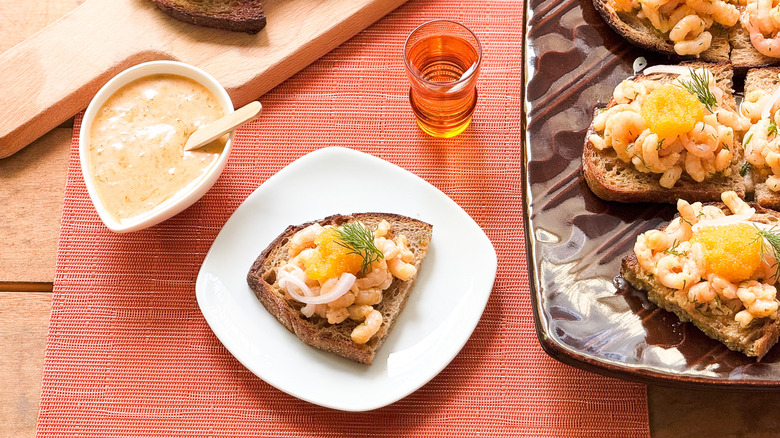
Ingredients
- 1 large fresh egg yolk
- 1 teaspoon Dijon mustard
- 2 teaspoons white wine vinegar
- ¾ cup neutral vegetable oil (sunflower, safflower, or canola)
- 12 ounces pre-cooked petite shrimp (thawed, if frozen)
- 2 tablespoons chopped fresh dill
- 1 tablespoon creamed horseradish
- 1 tablespoon freshly squeezed lemon juice
- ½ teaspoon smoked Spanish paprika
- ½ teaspoon sea salt
- ¼ teaspoon white pepper
- 2 tablespoons unsalted European-style butter
- 4 large slices rye bread
- 1 small (2-ounce) jar whitefish roe
- 2 tablespoons thinly sliced shallot
- 2 tablespoons fresh dill sprigs
Directions
- For the mayonnaise, set a medium-sized bowl over a folded towel for stability and add the egg yolk, mustard, and vinegar.
- Whisk together until smooth.
- Slowly add the oil, drop by drop, while whisking constantly.
- Once the mixture starts to thicken, increase the oil to a steady stream and whisk constantly to emulsify.
- Add the chopped dill, horseradish, lemon juice, smoked paprika, sea salt, and white pepper, whisking to combine.
- Pat the shrimp dry and place it in a bowl large enough for mixing.
- Add ⅔ cup of the mayonnaise dressing to the shrimp and gently toss to combine. Reserve the remaining dressing.
- Cover the bowl and chill until ready to use.
- Melt the butter in a large, heavy skillet over medium heat.
- Add the bread slices and cook for about 5 minutes.
- Turn the slices and cook on the other side until golden and toasted.
- Transfer the toast to a cutting board and cut into halves.
- Arrange the toast on a serving platter.
- Top the toast with the shrimp salad.
- Garnish the shrimp salad with a spoonful of roe, a few shallot slices, and a sprig of fresh dill.
- Serve the toast Skagen immediately, with the extra dressing on the side for drizzling.
| Calories per Serving | 621 |
| Total Fat | 53.4 g |
| Saturated Fat | 7.7 g |
| Trans Fat | 0.3 g |
| Cholesterol | 410.3 mg |
| Total Carbohydrates | 7.1 g |
| Dietary Fiber | 1.0 g |
| Total Sugars | 1.2 g |
| Sodium | 474.6 mg |
| Protein | 31.5 g |
What is the origin of toast Skagen?
The invention of toast Skagen is credited to Swedish chef Tore Wretman. Wretman was a successful restaurateur in Stockholm and an avid nautical enthusiast. Legend has it that he may have created the dish from simple ingredients on board his boat while sailing off the coast of Skagen in 1956 during a sailing competition. He used simple ingredients from his supplies on board to create a comforting bite that would cheer up his losing crew.
The creation was a success, so Wretman introduced a more sophisticated version to his diners in Stockholm. What makes this iconic starter so appealing is the layers of contrasting textures and flavors. The crisp buttery rye is a perfect vehicle for delivering the delicate shrimp and creamy sauce. Adding the roe gives the dish class and a celebratory feel. Kinnaird says that today in Sweden, toast Skagen is a fixture at Midsummer celebrations and is a popular menu item throughout the year.
What type of roe should you use for shrimp salad toast Skagen?
The terms roe and caviar are often used interchangeably, but not all roe is caviar. Both roe and caviar are fish eggs, but caviar comes from a specific source, whereas roe can refer to the unfertilized eggs of marine animals in general. Technically, salt-cured roe from the sturgeon family is classified as caviar. Often served from a mother-of-pearl spoon, caviar is considered an ultimate luxury yet was once considered to be peasant food.
As roe consumption increased over time, so did the culinary distinctions for different varieties. Toast Skagen is typically topped with golden whitefish roe, a mild and creamy variety with small eggs. This type of roe does not overpower the delicate shrimp flavor, and its texture is a subtle contrast to the creamy and crunchy layers. Kinnaird suggests trout roe for another mild-flavored and small beaded option in place of whitefish. Conversely, salmon roe tends to be a bit large and overly flavorful for this dish.
